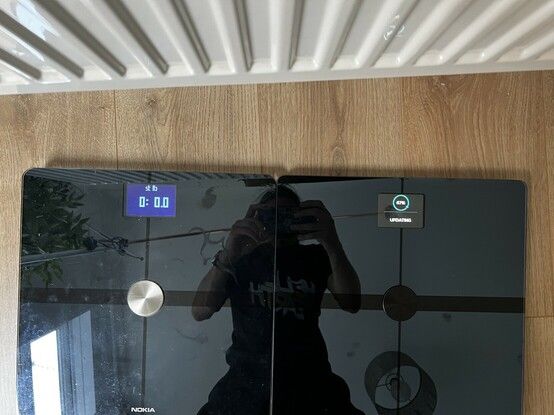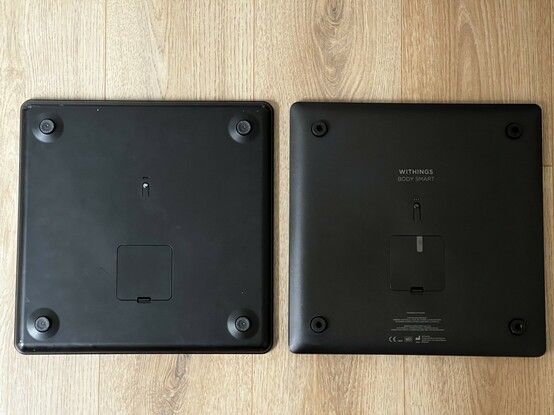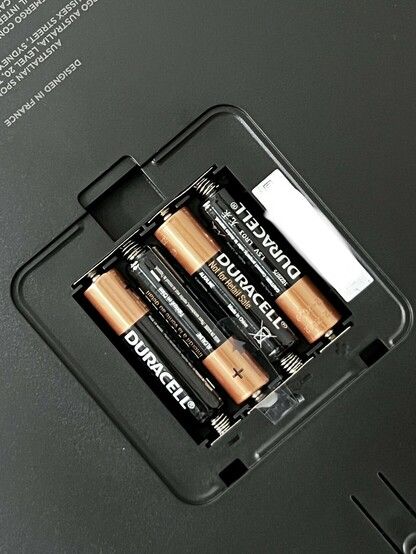Withings Body Smart Scales Reviewed
Since moving from the centre of hilly Sheffield, some five minute walk from work, to not so hilly Cambridge, where I fall out of bed and into the office, I’ve been on a gentle trajectory of weight gain, drifting from a modest 66kg up to 76kg. It doesn’t sound like a lot, but I can feel the difference and have decided to take steps to reverse course. It doesn’t help that I just smashed through my bodyweight in mixed grill, and that I really, really enjoy food. And that I’ve discovered mixing Old Jamaican ginger beer with Jamaican stout, or with Old Jamaican Pineapple soda to make extraordinarily addictive, sugary drinks. And that I keep baking cookies, and gingerbread and biscotti. But I digest… I mean digress… an instrumental piece of the weight loss puzzle is, you might be unsurprised to learn, actually knowing what your weight is. Enter Withings Body Smart scales.
My introduction to Withings was, as it happens, their Body+ scales, which I purchased back in February 2018 when they were still called Nokia. We didn’t have any scales at the time, and most options completely underwhelmed me. What drew me to Body+ was the promise of graphs and logging and various body composition features that would give me – and the rest of the family, it turns out – a little more insight into our health. It turned out that the Body+ was a wildly popular addition to our household and, instead of being consigned to a corner of the bathroom or a cupboard, it found a home in front of our living room mirror. Now I’m being, perhaps, slightly hyperbolic with wildly popular- but it certainly garnered more attention and more ongoing use than a conventional, mechanical bathroom scale might. At time of writing, since I now have the Body Smart on hand to review, it’s now found a new home with one of its frequent visitors.
I guess my point is that over five years and one ownership change later, my first Withings product is still going strong, is still compatible with their app, is still available for sale and – while it’s showing its age when contrasted with the slicker, fancier Body Smart – seems set to stick around for another five. Five years alone is a glacial age for a smart, connected product. By contrast the Nike Fuel Band – a sports tracker I really, really liked, darn it – barely lasted half this time and became effectively useless when it was discontinued.
It’s this endurance, and top notch products, that led me to not only work with Withings but become a lasting fan and a bit of a cheerleader for their brand. With this context in mind, let’s delve into the Body Smart, how it differs from and improves upon the Body+ and why you might prefer one over conventional, mechanical or disconnected digital scales.
Build
It says a lot about the Body+ that it’s still going strong after five years, and a lot more that Body Smart doesn’t stray too far from its original design- a fairly unassuming plastic base with a shiny (perhaps too shiny) glass top.
The Body Smart scale’s shiny new LCD blows the old Nokia Body+ out of the water. It’s like a smart mirror for your feet.
There are subtle differences- for starters the Nokia logo now reads Withings, and the machined aluminium disc that stuck out on the original design is now black, blended into the surface of the scales. It has the same glass top and the same division into four quadrants. The same general size, shape and thickness, and the same easy-open battery compartment and pair button underneath. The feet on the Body Smart have been designed slightly, to accommodate optional load-spreading, larger feet for use on carpeted floors (supplied).
It’s a foot redesign! Otherwise it’s quite obvious these are cut from the same cloth. Why change a winning formula?
The most striking change is the Body Smart’s shift to a vibrant, clear, colour LCD. It blends much better with the surface of the device, has better contrast and, importantly, has colour to convey weight, weather, air quality and other information in a more easy-to-glance fashion.
Morning Routine
Withings have positioned the Body Smart, and their other scales, as something more than a simple weight measuring device. They’ve delved a little deeper into “smart mirror” territory, attempting to make the scales a part of your morning routine. When you step on Body Smart it’ll weigh you, naturally, but it’ll follow shortly thereafter with various health information and a weather summary. But it doesn’t end there. Body Smart uses weight as a means to tell users apart (this has some downsides for privacy, more on that in a moment) and offers per-user customisation of its various information screens.
You can get a brief, personalised summary of your health, including a step counter albeit I’ve no earthly idea where it gets its step numbers from since they match neither my phone or my ScanWatch. Curious!
This one-shot information summary is great for habit forming. As someone who is thoroughly terrible at this, it’s been invaluable for enticing me and luring me into a daily weigh-in just before breakfast.
The on-screen graph of weight over time gives much more insight into the overarching trend of your weight loss. While on any given day you might swing back and forth, a phenomenon that encourages people not to weigh in to avoid disappointment, on Body Smart you see enough weight history to notice trends. Seeing these data points and being able to visualise a trend-line – it’s unfortunately not drawn for you – through the wavering data points is encouraging. Right now my weight is bouncing up and down around twelve stone, but has a noticeable downward trend that suggests I’m making progress back toward my preferred ten.
The App
Bathroom scales are not very photogenic, but this new LCD is purdy.
Since I last wrote about a Withings product, their “Health Mate” app has been – presumably because it clashes a little with Apple’s “Health” – renamed to “Withings.” If you’re bought into their ecosystem it’ll show you a comprehensive overview of your various health metrics across their watches, scales, blood-pressure devices and more.
Being able to see this same weight trend at any moment within Withings “Health Mate” app is also useful. It’s presented alongside your other health data and – and this is how I know how much I’ve put on – you can see your complete history at a glance.
The app includes a “Weight Breakdown” placing you on the somewhat controversial “BMI” scale which is a virtually meaningless, blunt instrument with a very dubious origin. Withings touch very lightly upon its problems, but still lean into it. This- in lieu of a better alternative- isn’t unreasonable but it’s disappointing that Withings – who are in possession of all the metrics to make more reasonable judgements on health outcomes – don’t even attempt to guess at anything better. Things like body composition, for example, which are omitted from BMI are the very same things that Withings measure. This is probably some kind of regulatory constraint and it seems Withings would rather you create a “Health Report” – a summary of your health data over a chosen period of time – and take it to a professional for evaluation.
Alongside weight you’ll also see a “Body Composition” section which shows a graph of fat vs muscle over time. Right now mine is pretty flat, but Withings claims I’m “Losing muscle.” I’m not totally surprised, since changing from skateboarding downhill to work on a daily basis to stumbling half-asleep into my home office has not exactly been conducive to exercise.
Right as I conclude this section Withings have dropped their 6.0 app update which refines and tweaks things. It’s an evolutionary upgrade, rather than a revolutionary one, but their healthy product ecosystem means they’re always iterating and improving. The app was, generally, pretty good, consistent and easy to navigate and this hasn’t changed.
Privacy
Perhaps one of the biggest downsides of a smart device tracking your – and your families – weight is the risk of weight data being inadvertently leaked to another family member, friend or otherwise. Not all privacy breaches need to involve the internet.
The Body Smart offers “Eyes Closed” mode, which removes any numerical data from the scale, but should your weight trajectory happen to intersect that of another family member (and user of the scale, of course) you’ll be shown your name and theirs when asked to assign your measurement. Whether or not this is a dealbreaker depends on your family, and it’s very easy to understand why a mechanical or regular digital scale – which records nothing – might be a preferred choice. If weight is, for whatever reason, a contentious issue in your household you might want to pass.
In addition to showing names when assigning readings, the primary owner of the Withings account associated with the scale will have access to a list of “Unknown Measurements.” That’s to say that should a friend, family member, visitor or otherwise happen to hop upon the scale and not be recognised as a user their weight will be whisked off into The Cloud and visible to the owner of the scale.
Repeatability / Accuracy
Since I’m relying solely on Body Smart to tell me my weight, I can’t really vouch for its accuracy. It is, however, an extremely sensitive and rather clever scale. The “leaning” I mentioned beforehand is facilitated by multiple separate weight sensors that work in concert to detect how your weight is shifted on the scale. It is, in effect, a Wii balance board- assuming you have any idea what I’m talking about.
I can tell you that it’s accurate enough that changes in clothing, or something as silly as having your hefty smartphone in your pyjama pocket can affect your weight measurement, however. With some not-exactly-scientific testing I saw variances in my weight, measured successively, of about +- 0.1lb. Without the subjectivity of reading an analog needle sort-of pointing at a particular mark on a dial, it’s all too easy to find swings in weight alarming- but I reiterate that it’s the general trend that counts.
Measuring body composition- muscle and fat density – happens near instantaneously and is completely imperceptible. The same applies to heart rate. They feel like magic, or would – I suppose – if you could feel anything while they were being measured.
I still have no earthly clue where it’s getting my step count from…
Battery Life
The Body Smart takes four AAA batteries. Right now we’re at roughly three months with regular use between two people and 39% capacity remaining using the supplied batteries.
Four AAA batteries is at least an even number. These will get swapped with rechargeable ones once they run out.
This is a far, far cry from the 15 months average usage that Withings claim and seems on track to something like 5 months. Only time will tell. The Body smart will happily run from rechargeable batteries, though, so you could swap between two sets of four to avoid disposable ones.
Overall
It’s hard to find much more to say about a set of, ostensibly, bathroom scales. It is perhaps sufficient to reiterate that they haven’t been consigned to the bathroom- they’re a key part of the morning routine and get a spot in the living room. I should also mention that- well- anything that gets me to form any semi-regular habit must be doing something right. It’s also quite telling that someone was lined up to snag our five year old set of Nokia Body+ scales that the Body Smart replaced.



